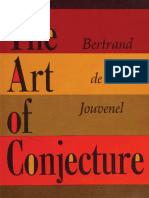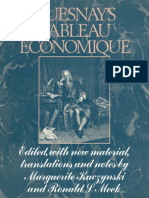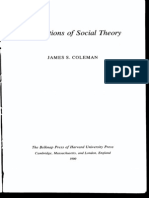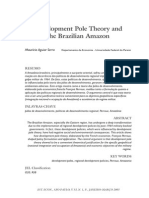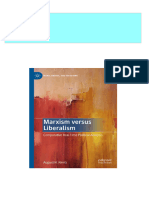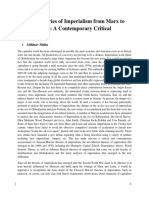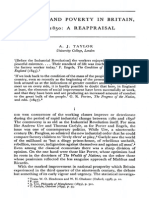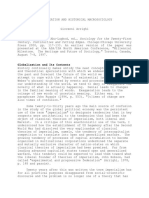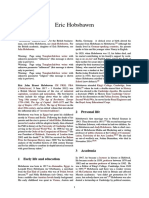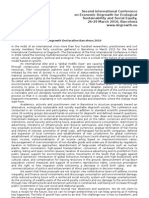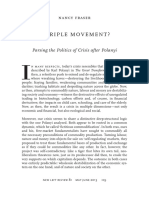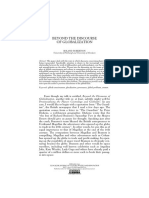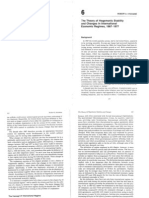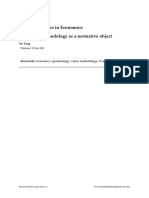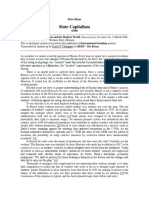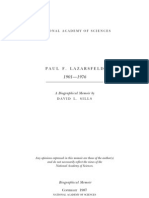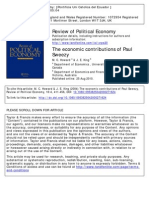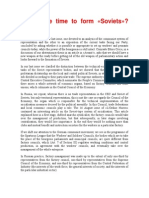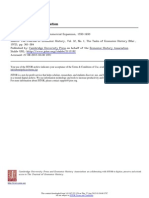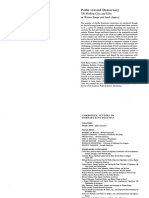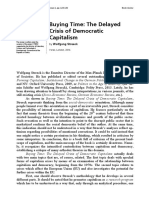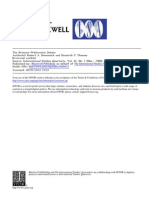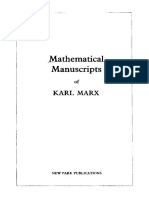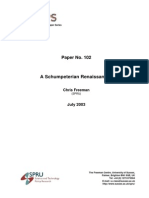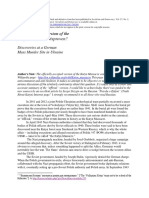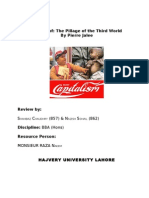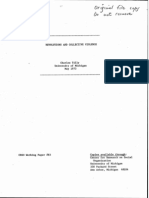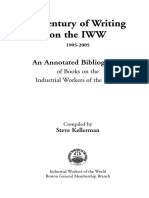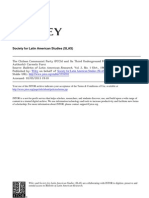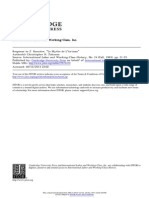Eric Hobsbawm - The Crisis of Capitalism in Historical Perspective
Eric Hobsbawm - The Crisis of Capitalism in Historical Perspective
Uploaded by
popolovskyCopyright:
Available Formats
Eric Hobsbawm - The Crisis of Capitalism in Historical Perspective
Eric Hobsbawm - The Crisis of Capitalism in Historical Perspective
Uploaded by
popolovskyCopyright
Available Formats
Share this document
Did you find this document useful?
Is this content inappropriate?
Copyright:
Available Formats
Eric Hobsbawm - The Crisis of Capitalism in Historical Perspective
Eric Hobsbawm - The Crisis of Capitalism in Historical Perspective
Uploaded by
popolovskyCopyright:
Available Formats
300
MARXISM TODAY, OCTOBER, 1 9 7 5
The Crisis of Capitalism in Historical Perspective
Professor Eric Hobsbawm
{We print below the text of a lecture given by Professor Hobsbawm auspices of the J. D. Bernal Peace Library^ Everyone has known for a long time that the operations of the capitalist economy generate various types of periodic disturbance which gives it a sort of jerky rhythm. The best-known of these rhythms is the so-called trade-cycle, namely the slump, which was discovered by radical and socialist economists from the 1830s on, and analysed by the orthodox from 1860 on. Sometimes it has been more dramatic than at other times, sometimesand notably in the years since the Second World Warit has been so mild that people have seriously doubted whether it was still in operation. Certainly it has been much less visible and important than ever before in capitalist history. However, though some of these slumps were catastrophic in their impact, both on business and on different classes of the people, with one exception none of them by themselves has looked like putting the capitalist system itself at risk on a world scale, nor possibly in any individual country. That exception is, of course, the slump of 1929 to 1933. Periodical Fluctuations Once the rhythm of the trade-cycle was recognised, slumps were, for the best part of a century, regarded as inevitable but temporary interruptions, analogous to the less predictable, but certainly periodic cycle of harvests which dominated the lives of pre-industrial societies. Capitalism lived with them, capitalism lived through them, capitalism survived them. However, perhaps it is less well known that there also appears to be a rather longer kind of periodical fluctuation in the course of capitalism, which the Russian economist, Koudratiev, tried to analyse in the 1920s, and which is still called by his name. Periods of 20 to 30 years or sothe exact length doesn't really matterappear to alternate, marked until the present by the different movements of prices. Deflations succeeded inflations for fairly long periods. Then we may also detect a longer trend of this kind, a general tendency of prices to fall from the beginning of the 19th century, the end of the Napoleonic Wars, until almost the end, and on March 5, 1975, under the a general trend of prices to rise, of which we are only too well awarea long-term trendsince the beginning of the 20th century. Periods of prosperity and capitalist expansion have thus alternated with periods of economic, and, as we shall see, with periods of political and social troubles. I think of this, of course, in terms of the assessment of business men. What happened to the common working people depended on other, admittedly connected, factors, so that some periods of business difficulties could see important improvements in the standards of living, and some periods of prosperity the opposite. But this is by the way. From the beginning of the Industrial Revolution to the end of the Napoleonic Wars was one such period of longterm trend. It was followed, until the middle or late 1840s, by a period of difficulties, though of rapid economic growth, and this in turn by the golden years of the mid-nineteenth century, the high point of capitalist, liberal, economics. From 1873 until almost the end of the century there was a period of difficulties called by contemporary business observers and also by some economic historians the "Great Depression", although, of course, it had only very small similarities with the Great Depression of the 1930s, which is what we know by this name. It was followed by another period of lengthy boom which lasted, I suppose, until the end of the First World War; thereafter came the depressed interwar years which did not really end until after the Second World War, and lastly the greatest of all global booms in the 1950s, 1960s and early 1970s, reaching its peak, as far as we can see, in 1973. It looks as though we have now entered another period of general economic difficulties. I don't particularly want to stress the periodicity of these fluctuations, though in a rough way they do allow us some predictions. The point I wish to make is that each of these periods of troubles in the past was in some sense the result of the successes of the previous period. Each boom created the conditions which, as we now see, led inevitably to the
PRODUCED BY UNZ.ORG ELECTRONIC REPRODUCTION PROHIBITED
MARXISM lODAY, OCIOBER, 1975
301
subsequent difficulties. But I am also bound to point out that, until the present, each of these periods of trouble led to changes within the capitalist system which in turn provided solutions for the problems previously raised, and created the conditions for the subsequent secular boom. Now the point I wish to malce is that the times when the viability of the entire capitalist system could be questioned have occurred during these rather lengthy periods of trouble, between 1815 and 1848, beween 1873 and 1896, and between 1917 and 1948. It is during these periods that we can speak of a crisis of capitalism. Types of Social and Political Conflicts I have so far talked in what looks like entirely economic terms, but of course we are not talking about the economic mechanism in isolation, even on a world scale; we are talking about societies divided into classes and other social groups, organised in a system and a hierarchy of states with particular forms of political institutions. Moreover, we are not only concerned with the interaction within the international system, but with all these at a particular phase of history. For even if, from the Industrial Revolution on, we can speak of a world dominated by capitalism, we cannot yet speak ofin fact we can never speak ofa uniformly and homogeneously capitalist world. Capitalism, or bourgeois society, captured the world progressively, transformed its various parts which were in very diiferent phases of their own development at various times, and, what is more, progressed and still progresses at an uneven rate. This is true of the poor countries of the capitalist system, and of the so-called developed or industrialised countries of the West, and later lapan. All this is familiar. The Industrial Revolution before 1848 was virtually confined to Britain, Belgium and a few patches in Western Europe and the European seaboard. The Industrial Revolution in Germany and most of the US occurs after 1848, in Scandinavia even later, in Russia from the 1890s, and so on. So what we are confronted with is a global, historical process, producing at least three types of social and political conflicts, in addition to, or rather in combination with, economic contradictions within capitalist development and complicated, moreover, by the unevenness of the transformation and timing in the various parts of the world. The first of these conflicts is the development, within the developed and developing countries, of a working class and its movements which are in conflict with the capitalists. The second is the resistance and developing rebellion of the dependent world, colonial and semi-colonial, against the domination of, or conquest by, the
handful of developed countries. One might perhaps also add at this stage yet another contradictionthough it tends to be of a slightly different kindthe resistance of pre-capitalist strata such as the peasants and petit-bourgeoisie in the developed or semi-peripheral countries, to the process of capitalist development which destroyed their traditional economy and social order. And finally there is the conflict between the various core states of capitalism themselves, an international conflict, and the various other complications of international rivalry and struggle which are essentially the concern of Bernal's and other people's work in favour of world peace. The Age of British Power I do not wish to suggest that these three conflicts exhaust the analysis, but for the sake of simplicity let us just concentrate on them. Now, until about the last quarter of the 19th century none of these three major conflicts could be expected to be acute on a global scale: industrialisation was only just beginning to produce massive proletariats, except in very few places such as Britain. Again, with certain exceptions, capitalism was only beginning to seize hold of the under-developed world from the middle of the 19th century on, and to engage in intensive capitalist investment there. Very little of the world was actually colonised, occupied and ruled from abroad, the major exceptions being India and what today is Indonesia. And since there was for more than half a century only one major industrial power, one workshop of the world and world trader, one power with a genuinely global policy and the means to exercise itmainly through a global navythe scope for major international conflict such as general, European or world war, was rather small. In world history this era, stretching from the defeat of Napoleon to the 1870s, perhaps to the end of the century if you like, may be described as the age of British power. It is this sort of world control of which the US has dreamed ever since 1941, and which it thought it had established in the 1950s and 1960s; but if the British era lasted little more than half a century, three-quarters perhaps, what the Americans call the American century turns out to have lasted little more than 25 years. But this is by the way. At all events, the moment when world capitalism was entirely successful, confident and secure, was comparatively brief, the mid-Victorian period, which may possibly be prolonged towards the end of the 19th century. In history this period is preceded by and followed by two ages of revolution: the first from, say, 1776, the date of the American Revolt, to 1848, about 70 odd years, the second the 70 odd years since the first Russian
PRODUCED BY UNZ.ORG ELECTRONIC REPRODUCTION PROHIBITED
302
MARXISM TODAY, OCTOBER, 1 9 7 5
Revolution of 1905. This latter age of revolution is evidently not yet over. I shall have a little to say about it later, but before I do so, a word about the first age of revolution. Why was it revolutionary? Because, as we see, looking back on it, it was a transition to the era of modern industrial capitalism, to bourgeois society; and what made it revolutionary was not only the attempt to break the fetters of earlier social and political orders which were believed to stand in its way, to construct an international system suited to the expansion of capitalism, but, I suggest, two further factors. First, the mobilisation of the common people which this revolutionary transition implied; that is why some phases of it have sometimes been called the age of democratic revolution: peasants, artisans, small shopkeepers, miscellaneous poor, were drawn into the drama of history as actors, rather than simply as crowd extras. Second, difficulties of developing industrial capitalism itself, which still found itself hampered by the very narrowness of the front on whirh it had broken through. It thereforeI shall not bother about going into detailscreated both unusually acute social problems, unusual hardships for the emerging, exploited working class, a mass of people whom at this stage it was better at uprooting than at finding work, not even work at the modest wages then believed to be adequate. It also created difficulties for business. All this made the 1830s and the 1840s a period of unusually persistent and acute crisis; so much so that manynot least among the capitalists themselvesfeared that the first stage of successful industrial capitalism might also be its last. The spectre of Communism haunted Europe. Looking back we can see that this was not the end of capitalism but what today would be called in the jargon "teething troubles". But we can properly consider this as the first era of general capitalist crisis. From this crisis capitalism emerged in the 1850s, the years of railways, iron and free trade, and above all the era when the world as a whole was opened to capitalist development (which did not necessarily mean industrialisation), or the exploitation by the developed and developing industrial powers. Mid-Nineteenth Century Boom The giant and prolonged boom of the midnineteenth century was not based on a new technological breakthrough; by and large it utilised and acknowledged and developed the first Industrial Revolution, coal as a source of energy, the steam-engine as motor-power, iron rather than steel as the basic raw material for capital goods such as machinery and so on. But this technology
was now used on a far greater scale internationally both in the countries which were now entering industrialisation, and also to create what is nowadays called an infrastructure in colonial and semi-colonial under-developed areas, railways, port installationsall that sort of thing. These allowed them to be integrated, mainly as suppliers of primary products into the capitalist world economy. Hence the three major consequences of this boom: first, it replaced industrial world monopoly by Britain, by what you might call world industrial oligarchy by a handful of competing industrial powers among whom the USA and Germany were rapidly overhauling Britain. We shall see that this situation has some parallels with the present. So long as the technology and methods of the first Industrial Revolution were very basic to industrialisation, this did not diminish the industrial role of Britain, but eventually it would do so. Second, in making possible through railways, steamships, etc., an economic trade in bulk goods from hitherto inaccessible areas, it created a number of potential mass exporters of primary products, generally specialising in one or two commoditiesAmerican and South Russian wheat, Argentinian and Australasian meat, South Asian tea, Latin American coffee, etc.each dependent on the developed industrial world for their outlets. When these became actual rather than just potential mass exporters, the result would be a major disruption of agriculture, both in the exporting and importing countries, and also the development of dependent, mono-culture export economies like the banana and cofl^ee republics of Latin America. But once again this only began to happen after the period of boom in the 1870s and 1880s, i.e. during the crisis which followed. Third, and in consequence of the first two developments, the boom enormously expanded imports and exports of both goods and capital. This world trading and payments system continued to hinge on Britain and in this respect the British economy continued to occupy a key position even after its industrial role began to diminish. However, the boom was particularly quick in getting under way because of two further factors: a rather large reserve of hitherto under-utilised resources, notably the labour which had been uprooted but was available for fairly short-term employment, and the discovery of vast supplies of precious metals, mostly gold, in California and Australia, but also silver in the USA. The reserves of labour, although reinforced by a considerable degree of immigration from agriculture to industry and to the cities, were still only
PRODUCED BY UNZ.ORG ELECTRONIC REPRODUCTION PROHIBITED
MARXISM TODAY, OCTOBER, 1975
303
a small part of what was really available in the world. For practical purposes during this period up to the 1880s, the only mass emigration came from Britain, Ireland and Germany. I am deliberately over-simplifyinga little bitbut by and large this is a fair statement. The precious metals as well as the enormous expansion of the international market for goods, whose output may have somewhat lagged behind the demand, helped to create a moderate inflation of pricesit's the only period between 1850 and the end of the century when prices were not tending to drop^and, in short, there was no pressure on business profits. Quite the contrary. Except for greatly improved employment, the workers got little enough out of this boom, but on the whole conditions in developed countries improved after I860 at least, and the prospects of capitalism looked extremely rosy. Last Quarter of Nineteenth Century As I have already implied, the great boom created its own troubles which became obvious in the last quarter of the 19th century. But, with some qualifications which I shall shortly be making, these troubles were, as we can see in retrospect, not fundamental. This is why most economic historians today take the phrase "The Great Depression", which was then widely used, with a very large pinch of salt, and many actually refuse to accept that it was a depression at all. What we find is not a general crisis of capitalism but a shift within it: from the technology of steam and iron and a limited knowledge of chemistry to electricity and oil, steel alloys and non-ferrous metals, turbines and internal-combustion engines; from competitive small firms to corporations, cartels and trusts; from free trade to protection and the partition of the world; frorn one industrial economy to several rival industrial economies; in short, from mid-19th century capitalism to imperialism or monopoly capitalism. Expansion in terms of output and trade continued faster than before, even during the period when businessmen complained of the squeeze on profits and the rate of interest. Probably agriculture rather than industry took the main brunt of the crisis, but incidentally the consequent rapid fall of the cost of living benefited a lot of workers, notably in Britain. By the end of the 19th century this period of troubles seemed at an end. Another era of longterm expansion and prosperity for capitalism seemed to be due. Marxists, who had assumed that the crisis would go on, were at a loss. The so-called "crisis of Marxism" associated with the debates in connection with Bernstein's attempts to revise Marx, occurs just about at the moment
when the crisis of capitalism gives way to this new era of expansion, around 1897. At about the same time, however, a new phase of discussion about Marxism begins: the word "Marxism" itself emerges and the discussion of imperialism as a new phase of the development of capitalism begins. From then on this is an essential part of Marxist discussions, as witness the writings of Lenin in 1916. After 1900 Now, even in a purely economic sense, capitalism seemed set for a long and untroubled future around 1900. Even British capitalism, which was by now lumbered with a lot of oldfashioned plant and methods, and both slowing down and falling behind the Germans and Americans, enjoyed the profits of being both the largest empire and increasingly the world's financier, shipper, insurance-broker, and in general the advantages of a world system which rested on the pound sterling. And, in fact, of the three major areas of conflict within the capitalist system, the one which had seemed most dangerous before 1848 now appeared to become quite manageable. During the so-called "Great Depression" mass trade union and labour movements developed in all industrial countries, even to a substantial extent in the U S \ , mostly socialist and indeed largely Marxist. But, in fact, though these Marxist mass movements continued to salute the flag of revolution every time their leaders opened their mouths in public, we know that they rapidly turned into harmless, socialdemocratic movements, though not, of course, in the illegal and marginal movements in the peripheral and under-developed countries such as Russia. On the other hand, the two other types of conflict now became increasingly dangerous. The pressures of imperialism on parts of the colonial and semi-colonial world, including countries on the margins of capitalist development, such as Tsarist Russia, became intolerable. Between 1905 and 1914 breaking-point was reached in three areas. One, the traditional structures of precapitalist empires in the Islamic world and Asia collapsed under the pressure of western penetration and conquest: Tsarist Russia, in so far as it belonged to this group, Persia, Turkey and, most significant of all in 1911, China. Second, social revolution of peasants and workers broke out in Tsarist Russia, the first major social revolution of the 20th century. And, third, in Mexico in 1910 there occurred the first anti-imperialist social revolution in which the workers played no significant part because they did not form a significant part of the population.
PRODUCED BY UNZ.ORG ELECTRONIC REPRODUCTION PROHIBITED
304
MARXISM lODAY, OCTOBER, 1 9 7 3
These developments constitute the beginnings of the 20th century age of revolutions. At the same time the tensions of the state system led directly towards an era of international wars such as had not existed since the 18th and early 19th century. The first of these wars, expected, predicted, and in spite of great efforts not avoided, ended the era of triumphant confidence. After 1914 nothing would ever really be the same again. Then after 1917 one-sixth of the world's surface moved out of the capitalist economy and after the Second World War large regions of Europe and Asia joined this movement. Capitalism was not destroyed as a world system, but the First World War opened an era when ail three of the main types of conflict became for a time apparently dominant and unmanageable. The threat of social revolution dominated the politics of most of the highly developed capitalist states, though the operative factor at times was not so much the reality of this threat of social revolution as the fear of revolution in the minds of an uncertain, frightened, demoralised ruling class. This was particularly so in the period following the October Revolution and during the Great Depression. International conflict became endemic as a second and even greater world war followed the first after barely 20 years' interval of a very uncertain peace. And the great empires into which the world had been divided at the end of the 19th century now lived on borrowed time. Their end could be predicted. But what made this entire period so dramatic a crisis was the breakdown of the international capitalist economy which had, by and large, had such an astonishing run for its moneythe money being the pound sterlinguntil 1914. The attempt to reconstruct this international liberal economy after the First World War in the 1920s failed. For one thing the keystone of the whole structure, Britain, was no longer in a position to bear its weight: the great slump of 1929 to 1933 showed just how unsuccessful this attempt had been, and brought the system close to actual collapse for a brief moment. To give you a single illustration: in 1938 world trade was little more than two-thirds of what it had been in 1913, and in 1948 European trade was about 15 per cent below this modest level. There had been no setback of this kind since the beginning of the Industrial Revolution. The period of depression, flanked on either side by war and revolution, remains to this day the only time when the future of the world capitalist system really looked as though it was in imminent danger. It did not seem unrealistic to speak in the words of a contemporary book-title of This Final Crisis. But, as we can see now, the
immediate and urgent danger to capitalism was not due to the fact that the system had come to the end of its possibilities either economically or politically; it had merely come to the end of the possibilities of its 19th-century international structure and the assumptions on which its policy had then been based. The slump forced one country after another to abandon these, and Keyneswho you may remember set out to save rather than to undermine bourgeois societyprovided the most familiar, theoretical reasoning behind this change. Actually, in all countries, even including Scandinavia, this change took place through a combination of experiment, accident and the discovery that even the slump of 1929 to 1933 ended of its own accord, and of course subsequently by the necessity of an economy of total war. Some Errors of Marxists I am sorry to say that the Marxists failed to recognise this change, and this intellectual and political failure is probably responsible for the revival of a revolutionary left in the late 1960s which largely abandoned the proper analysis of capitalism for a blind and sometimes anti-rational activism, or for general and highly abstract philosophical speculations or for other plainly inadequate theoretical approaches. Let me spell out, somewhat self-critically, a few of our errors: we thought that capitalism could recover only as part of the preparations for war. But this was wrong. The total expenditure on armaments in the post-war period has been vastly greater than ever before. This is not the only, or perhaps not the main, reason why world capitalism during the 1950s and 1960s flourished as never before. We thought liberal, parliamentary democracy was finished, but fascism and similar regimes proved to be temporary aberrations, a reflection of the inter-war depression era rather than the future pattern of capitalist politics; and if the word fascism had not lost all meaning in current political discussion, this would be more clearly realised. The New Great Boom The capitalist states of the new great boom moved back to some variant or other of an admittedly very much more bureaucratised and, so to speak, state-administered bourgeois parliamentarianism. We thought that declining capitalism would be unable to compete successfully with the rising rival socialist economy, especially one so much larger than before. But the opposite happened. Capitalism outproduced socialism and even began to re-infiltrate and re-integrate socialist economy from outside by virtue of its
PRODUCED BY UNZ.ORG ELECTRONIC REPRODUCTION PROHIBITED
MARXISM loUAY, OCIOBER,
1975
305
technological superiority and greater wealth. And so on. So it is clear that the foundations of capitalism have not been fatally undermined by the era of crisis, profound though that crisis was. What happened is rather that capitalism abandoned the old assumption of a self-regulating, competitive market economy and changed its structure accordingly. In the first place the state expanded its economic function in all developed countries, including the USA, to the point where it deliberately planned and managed the economy to a large extent, including an enormous public sector, and in many countries, even a largely nationalised industry. In the second place, the developed economies abandoned the economies of cheap labour and market control of unemployment, thus incidentally making possible a vast extension of the market for consumer goods. In the third place, the concentration of capital created the phenomenon of the modern, supergiant, largely self-financing, independent-of-themarket, transnational corporation. The developed countries entered the era of state monopoly capitalism and welfare capitalism inasmuch as welfare is implicit in full employment as a major government policy which automatically maintains workers' incomes. I do not want to describe or analyse these farreaching changes further: but 1 want just to point out that phrases like "state capitalism" or "state monopoly capitalism" obscure one very important aspect of this new relation between the state and the large corporations which increasingly and in all developed countries constitute the "private sector". The corporations both need the state I mean the national stateand break its boundaries. They need it, and not only for various other purposes, but because it controls the conditions of political stability which makes the operation of the system possible in the post-1930 period, i.e. full employment and social security. These conditions depend on a constantly rising level of state expenditure. In the USA. for instance, it has risen from about 24 per cent of GNP 1948 to about 32 per cent in 1969. And every time it drops, unemployment rises. But at the same time the operations of the giant corporations become steadily more transnational, whatever their local base (which in most cases is American), and therefore to some extent they come into conflict with the interests of the economic policy of the national states; for instance, in the matter of the balance of payments. The fact that the United States has run an enormous deficit for many yearsin the 1950s and 1960swhich in the end undermined the position of the dollar, was of considerable negative importance to the US Government, but it
was an undoubted advantage to the American transnational corporations which used this fact to buy themselves into foreign economies. Hence, incidentally, the post-war international economy has not on the whole been one of mere mercantilism, as some Keynesians anticipated, but a sort of world restoration of free trade and free investment for the benefit of what is now, one might say, the major dynamic element in the capitalist economy, the large transnational corporations. Given this restructuring of capitalism, its recovery was facilitated by the large reserve of unused resources, industrial capacity of labour available at the end of the war, and by the disproportion which had widened during the period of economic crisis, between the growing capacity to produce and the stagnation of world trade. It was also made possible by the systematic reconstruction, in which incidentally Keynes also took a leading part, of an international trade and payments system in the immediate post-war years. As I have already suggested, this system was in some respects a reversion to the mid-]9th century order, only it rested on a US world monopoly instead of a British, on the dollar instead of on the pound sterling. But the unparalleled expansion of capitalism could not have occurred but for important changes in the level of the means of production, just as the previous expansions also occurred not simply by a widening of the market and changes in the structure, but also by changes in the means of production; changes comparable to cotton in the first Industrial Revolution, to railways and iron in the mid-19th century, to the new technology that I have sketched above of the early 20th century. Three Key Factors I would like to suggest three changes of this kind, not necessarily in order of importance. First, in addition to the generalisation of the internal combustion engine, the spread of the car from being virtually an American phenomenon to being a world phenomenon, there were the consequences of the technological revolutionin the field of light consumer goodsof electronics and plastics. Most of these, incidentally, like most of the technological revolutions which paid off in the later periods of boom, were made during the inter-war period, or at least during the period of crisis. The technological revolution in light consumer goods, electronics and plastics, created an enormous number of new consumer goods, and increasingly cheapening consumer goodsyou may observe that among the very few goods which still continue, even in the period of inflation, to become cheaper, are things like colour
PRODUCED BY UNZ.ORG ELECTRONIC REPRODUCTION PROHIBITED
306
MARXISM TODAY, OCTOBER, 1 9 7 5
television sets. If we look at a country like Japan, the consumer society there is based much less on the car than on the camera and the television set. That was a development in the fifties and sixties. Second, there is something which perhaps made possible what I have just described, a really quite unprecedented developmentat least unprecedented on this scalean enormous, massive process of urbanisation or sub-urbanisation, the emptying of the countryside. In the 1950s and particularly in the 1960s, for the first time in Western and Central Europe, the oldnot only Marxistprediction of the disappearance of the peasant appeared to be coming true; they disappeared in the physical sense; great numbers of villages were emptied in England, Wales, Scotland, as well as in Central France, and were increasingly colonised by people like most of those in this room, or by their parents, as second homes. This phenomenon is not necessarily confined only to developed countries; urbanisation, sub-urbanisation, the consequent road-building and all the rest of it, also occurred in the peripheral and even in many of the under-developed countries, very notably in a region like Latin America. Third, I think we have the systematic exploitation, again on quite an unprecedented scale, of ultra-cheap energy. This was not energy that has previously been unknown, because oil, after all, had been significant in the past. However, there was now exploitation of oil on a scale, particularly after the late fifties, which simply had no precedent. Alternative sources of energy were run downcoal mines, for instance, shut down, right, left and centrein order to use the benefits, the advantages of this bonanza of ultra-cheap oil. We may also, however, note that capitalism began to do two things, one old and one new: first, unlike the inter-war periods, it once again relied very largely on immigrant labour, the abundant and cheap labour on its fringes. There were no longer such large reserves in central capitalist countries with full employment where the only unused labour capacity was that of married womenthe percentage of employed married women shot up dramatically. Again there was no precedent for this post-war period rise in women's employment. We now find immigration, very notably controlled immigration in some instances, in Europe, from places as far away as Turkey, or Syria, in some instances, not to mention Asia and the West Indies. But we also find a new phenomenon: the export of the actual plant and industry to the areas where the reservoir of cheap labour was, to places like South Korea, Taiwan, Singapore. In the last ten years such transfers have taken place on a large scale.
certainly in industries like electronics and cameras. In short, the exploitation of the underdeveloped world, both in labour and raw materials, by the developed world contributed to an important extentand some would argue fundamentallyto the great boom of the 1950s and 1960s. Now during this golden age of capitalism we may note that two out of the three main conflicts I have talked about ceased to be acute, at least for this period. After a few years of sharp confrontation, the USA and the USSR developed a stable modus vivendi, and in spite of bloody local wars an immediate world conflict has for several years appeared to be unlikely. Similarly the working class movements in the developed countries, whether under social-democratic or Marxist leadership, also establishedthere was little else to doa modus vivendi with the existing system, which they screwed for all they were worth for the higher wages and better conditions which at that period the system was perfectly able to grant. At the same time one must note that this particular conflict became complicated and changed by a new tendency. The actual size of the industrial working class tended to decline with the growth of tertiary industries and a number of other groups who, though in some sense wageearners or salaried workers, were not members of the manual working class or organised in the same wayat least their labour was not organised in the same waythough increasingly they came to be integrated into labour movements, at least as trade union members. Only the tension between the industrial and the under-developed countries remained alive, given the widening gap between the two and the role of exploitation in the world boom. But once again, with a few localised exceptions such as Cuba and Vietnam, we cannot really regard this conflict as unmanageable in the period, let us say, between 1950 and 1973. Internal Contradictions It is not my business to analyse the internal contradictions which led to the end of this golden age, though I will in passing point out three: first, the United States was incapable of maintaining its overwhelming economic and political supremacy, and consequently of maintaining the dollar in its position as the basis of the international payment system. That system, visibly shaken since 1968, is at present on the point of breakdown. The revival or rise of other capitalist economies, notably those in the EEC and Japan, puts the US today in a similar relationship to them as Britain was from the end of the 19th century in relation to Germany and the USA. It
PRODUCED BY UNZ.ORG ELECTRONIC REPRODUCTION PROHIBITED
MARXISM TODAY, OCTOBER, 1 9 7 5
307
is no longer true to think of the USA as the overwhelmingly dominant, or even the technologically dominant, country. According to certain calculations, the GNP of West Germany is even now larger than that of the USA. Whether or not this is so, the point is that we are once again in a situation of international oligopoly, whereas in the early 1950s the US was overwhelmingly dominant in its wealth and productive capacity. International rivalry and tensions, therefore, revived as American hegemony declined. Second, it is now clear that capitalism can choose either unemployment or inflation. However, while a moderate degree of inflation is rather good for business, an excessive amount produces, as we know too well, considerable social and economic political troubles. Moreover, it is possibleand the subject hasn't really been adequately analysed at all because the whole business of the nature of the present economy has always left the economists in a state of great puzzlementincluding, I should add, the Marxist economistsit is possible that the structure of capitalism has changed in such a way as to make it increasingly difficult to control either inflation by means of unemployment, or the other way round. Or rather that one would need an unpredictably greater amount of unemployment than was previously believed necessary to control inflation and the other way round. And third, the now politically independent countries which happen to be sitting on scarce raw materials discovered how to turn the tables on the industrial world by using monopoly themselves, as in the oil crisis. In short, the era when capitalist corporations could operate at their will in a Third World of cheap resources was bound to end. And it did. The Present Period So we are once again at the end of another bout of capitalist expansion. I do not say of capitalism, since, again speaking in purely economic and technical terms, the system has not exhausted its possibilities. For instance, it could quite easily extend the method of exporting industrialisation to the underdeveloped world, which it has already started to do, and it would then acquire a very large, cheap labour force once again, for a while. It can, and it almost certainly will, invest heavily in the search for new sources of energy, nuclear and other, and such a massive investment programme might well open up yet another phase of rapid development. Its immediate weaknesses are a combination of the economic and the political, and its vulnerability lies in this combination and not in the insolubility of any specific economic difficulties taken in isola-
tion. Thus the reconstruction of the international monetary system has so far been prevented and this is for at least four yearsessentially by political frictions between the US and the European countries, with the socialist countries and the Third World countries intervening, since they also have their interests in this matter. The USA is no longer in the position it was at the end of the war to impose its own solution. No one is able to impose a solution in a situation of tension between rival groups. We may take it that even if the control of inflation by employment were technically possible, which, as I have suggested, is not certain, a return to mass unemployment on the inter-war scale is simply politically not on, both because governments in industrial countries fear the political consequence, and because the strength of organised labour movements in several of these countries makes such a course extremely difficult, if not impossible. If mass unemployment occurs again, it will not be the result of policy but of the breakdown of policy. The decline of the USA which has led to more freedom of action in smaller countries combined with the general atmosphere of uneasiness and fearnot least in the USAhas once again led to a much more explosive or potentially explosive international situation, from which once again major international conflicts may spring. The Vietnam War was terrible, but nobody seriously expected that it would widen into a world conflagration for more than the occasional moment. On the other hand, the Middle Eastern situation, particularly today and particularly in the last two years, is one which might well become a world crisis, into which the powers might quite well be drawn and from which they might not be able to escape. In this sense, once again, a period of economic difficulties and a period of political and international tensions combine and coincide. There remains, however, one major and intensifying problem, the widening gap between the industrial and the undeveloped world, much of which, though not all, remained on the margin of disaster even during the best years of the golden age, largely because it had not made social revolutions, and much of it may now be re-entering an age of famine rather than merely an age of poverty. The most recent revolutions we do not know whether they are the first of a new crop or mere isolated caseshave arisen out of this Third World situation. The changes in Portugal arose out of an anti-colonial rebellion, and the revolution in Ethiopia arose directlyat least it appears to have been stimulated directly by the experience of famine in that country. So far it remains true to say that capitalism is still
PRODUCED BY UNZ.ORG ELECTRONIC REPRODUCTION PROHIBITED
308
MARXISM TODAY, OCTOBIiR. 1 9 7 5
most vulnerable on its margins, though not on all margins. There is in particular one area in the world to which the great boom has so far brought no gain or much progress, and that is the area of South Asia where eight hundred million people live under conditions which have been little afifected even by the last 20 to 25 years of economic expansion and technological progress. This is in some senses the really vulnerable point in the world and the point where global tragedy is likely to begin, if there is to be such a tragedy. How shall I end this historic survey? Marx showed that the basic contradiction of the system was between the social nature of production and private appropriation. Capitalism got as far as it could by uncontrolled private enterprise until, say, the end of the 19th century. Thereafter it entered a severe crisis. It emerged from this only by turning itself into a managed, monopolist, state capitalism, i.e. by involving as much social organisation as was compatible with it in the system, and by eliminating a large amount of the element of competition and of the market economy. Yet the contradiction, remained. It remains within countries and, above all, on a global scale. It is clearly not impossible for capitalism to go yet further along the road of social organisation and planning of production, but while it remains
capitalism there must be limits for this process, though at present it would be unwise to make a firm statement about what these limits are. The main strength of the system has evidently lain in the impressive viability and stability and, above all, the powers of recovery of a hard core of the old industrialised economies. Western and Central Europe, the USA and Japan. Let us not underrate the blows that some of them have suffered; wars, slumps and so on, and from which they have so far recovered with one or two exceptions among which this country must be counted. Its main weakness, as I have already suggested, has lain both in the peripheral countries, such as Tsarist Russia once was, and in its relation with the underdeveloped world. However, such breakaways from world capitalism, as there have been, have not so far destroyed the general dominance on a world scale of the capitalist economy. Its main vulnerability has lain in the combination of economic difficulties with internal and international political conflicts. All of these have tended, and perhaps increasingly tended, to combine during the periodic down-swings of the alternating long waves, and at the turning points between these long-term periods, which I sketched at the beginning of this talk.
Discussion Contribution on:
Trotsky and the Popular Front
Monty Johnstone
Part I
Forty years ago, in July-August 1935, the Seventh World Congress of the Communist International approved and elaborated the strategy of the Popular Front. An understanding of that congress is essential for a serious appreciation of the subsequent policies and perspectives of Communist Parties all over the world, for which it laid the basis. Similarly, a major part of the criticism of Communist strategy in capitalist countries made from Trotskyist and "leftist" positions today proceeds from foundations laid by Leon Trotsky in his attack on "Popular Frontism" in the 1930s. An analysis of this attack, both theoretically and in relation to the specific situation and possibilities of the Popular Front in France, where it first emerged, may therefore have not only historical interest, but also relevance for Marxist debate on contemporary political strategy.^ The Seventh World Congress met to consider the political reorientation made necessary by Hitler's victory in Germany and the growing menace of ' For reasons of space the experience of the Spanish People's Front is only passingly referred to, and the antiimperialist people's fronts in colonial and semi-colonial countries (notably China) are not touched on at all. It is also impossible to go into the related question of the peace front and collective security, opposed by Trotsky in the thirties.
PRODUCED BY UNZ.ORG ELECTRONIC REPRODUCTION PROHIBITED
You might also like
- Bertrand de Jouvenel - Art of Conjecture-Basic Books (1967)Document311 pagesBertrand de Jouvenel - Art of Conjecture-Basic Books (1967)carlosNo ratings yet
- The System of Accumulation in South Africa Theories of Imperialism and Capital SOA - HigginbottomDocument27 pagesThe System of Accumulation in South Africa Theories of Imperialism and Capital SOA - HigginbottomShih-Yu Chou100% (1)
- WEHLER, Hans-Ulrich - Bismarck's Imperialism 1862-1890 PDFDocument37 pagesWEHLER, Hans-Ulrich - Bismarck's Imperialism 1862-1890 PDFdudcr100% (1)
- Marguerite Kuczynski, Ronald L. Meek (Eds.) - Quesnay's Tableau Économique-Palgrave Macmillan UK (1972)Document158 pagesMarguerite Kuczynski, Ronald L. Meek (Eds.) - Quesnay's Tableau Économique-Palgrave Macmillan UK (1972)miguelip01No ratings yet
- Las Quarter 2 Empowerment Technology Week 1Document6 pagesLas Quarter 2 Empowerment Technology Week 1Ruben Rosendal De Asis100% (6)
- Eric Hobsbawm World Distempers PDFDocument2 pagesEric Hobsbawm World Distempers PDFChristine100% (1)
- Bang, Peter - Antiquity Between Primitism and ModernismDocument14 pagesBang, Peter - Antiquity Between Primitism and ModernismJosé KnustNo ratings yet
- Coleman-Foundations of Social Theory-Ch 12Document23 pagesColeman-Foundations of Social Theory-Ch 12Radu-Florin Matei100% (1)
- Advanced Introduction To The Austrian School of EconomicsDocument3 pagesAdvanced Introduction To The Austrian School of EconomicsMikko ArevuoNo ratings yet
- Bosteels, Bruno - Hegel in Mexico Memory and Alienation in The Posthumous Writings by José RevueltasDocument25 pagesBosteels, Bruno - Hegel in Mexico Memory and Alienation in The Posthumous Writings by José RevueltaszvonomirNo ratings yet
- Service Manual: HP 5890 Series Ii Gas ChromatographDocument170 pagesService Manual: HP 5890 Series Ii Gas ChromatographRuben MartinezNo ratings yet
- SAS Weapons Grenade Launchers M79Document1 pageSAS Weapons Grenade Launchers M79S84SNo ratings yet
- Building A Successful Outbound Lead Generation TeamDocument80 pagesBuilding A Successful Outbound Lead Generation TeamFares100% (4)
- Growth Pole Theory - PerrouxDocument43 pagesGrowth Pole Theory - PerrouxpranjalsaraswatNo ratings yet
- (1992) André Gunder Frank. Nothing New in The East: No New World Order (In: Social Justice, Vol. 19, N° 1, Pp. 34-59)Document26 pages(1992) André Gunder Frank. Nothing New in The East: No New World Order (In: Social Justice, Vol. 19, N° 1, Pp. 34-59)Archivo André Gunder Frank [1929-2005]No ratings yet
- Full Marxism Versus Liberalism: Comparative Real-Time Political Analysis August H. Nimtz PDF All ChaptersDocument52 pagesFull Marxism Versus Liberalism: Comparative Real-Time Political Analysis August H. Nimtz PDF All Chaptersniuvisvarhol57100% (3)
- Seminar-Paper - 1st - Abhinav Sinha - EnglishDocument58 pagesSeminar-Paper - 1st - Abhinav Sinha - EnglishSuresh Chavhan100% (1)
- A. J. Taylor - Progress and Poverty in Britain, 1780-1850Document16 pagesA. J. Taylor - Progress and Poverty in Britain, 1780-1850Daniel Schneider BastosNo ratings yet
- WheatcroftDocument21 pagesWheatcroftRutenbündelbälle Mcschmalz100% (1)
- Buy ebook David Harvey A Critical Introduction to His Thought 1st Edition Noel Castree cheap priceDocument71 pagesBuy ebook David Harvey A Critical Introduction to His Thought 1st Edition Noel Castree cheap pricetofajhorn100% (2)
- GIOVANNI ARRIGHI - 2000 - Globalization and Historical Macrosociology PDFDocument17 pagesGIOVANNI ARRIGHI - 2000 - Globalization and Historical Macrosociology PDFManuel MenezesNo ratings yet
- Eric HobsbawmDocument10 pagesEric HobsbawmMarios DarvirasNo ratings yet
- Dewesternization and Islamization: Their Epistemic Framework and Final PurposeDocument18 pagesDewesternization and Islamization: Their Epistemic Framework and Final PurposeHaziq AsyrafNo ratings yet
- Degrowth Declaration Barcelona 2010Document1 pageDegrowth Declaration Barcelona 2010Samuele Lo PianoNo ratings yet
- Winch (2009) PDFDocument17 pagesWinch (2009) PDFXue MichelleNo ratings yet
- Fraser, A Triple Movement. Parsing The Politics of Crisis After Polanyi-2Document14 pagesFraser, A Triple Movement. Parsing The Politics of Crisis After Polanyi-2Julian GallegoNo ratings yet
- Roland Robertson - Beyond The Discourse of Globalization PDFDocument14 pagesRoland Robertson - Beyond The Discourse of Globalization PDFCamilaRivasNo ratings yet
- Advertising.: CritiqueDocument12 pagesAdvertising.: CritiqueMARY MAY ANGELESNo ratings yet
- Keohane Estabilidad HegDocument17 pagesKeohane Estabilidad HegMarcia PérezNo ratings yet
- Kalecki - 1962 - Observations On The Theory of GrowthDocument21 pagesKalecki - 1962 - Observations On The Theory of GrowthDanyel PalaciosNo ratings yet
- Epistemic Values in Economics: Economic Methodology As A Normative ObjectDocument12 pagesEpistemic Values in Economics: Economic Methodology As A Normative ObjectValentina Vera Cortés100% (1)
- Albert HirschmanDocument34 pagesAlbert HirschmanLuisa Fernanda QNo ratings yet
- Binns, Peter (1986) State CapitalismDocument8 pagesBinns, Peter (1986) State CapitalismSimud100% (1)
- Paul F. Lazarsfeld: National Academy of SciencesDocument34 pagesPaul F. Lazarsfeld: National Academy of SciencesSanja JankovićNo ratings yet
- Paul SweezyDocument47 pagesPaul SweezyRaphael Bahamonde Cobo de Figueroa0% (1)
- E.F. Schumacher: Idea of Development By:-Piyush RajDocument6 pagesE.F. Schumacher: Idea of Development By:-Piyush RajPiyush rajNo ratings yet
- Escritos Políticos Amadeo Bordiga (1919-1966)Document372 pagesEscritos Políticos Amadeo Bordiga (1919-1966)antoniojoseespNo ratings yet
- Albert J. Bergesen - Gunder Frank 19th Century ReorientingDocument68 pagesAlbert J. Bergesen - Gunder Frank 19th Century Reorientingpsychokill65No ratings yet
- (Print) Daniel R. Fusfeld - The Age of The Economist-Hist ReferenceDocument109 pages(Print) Daniel R. Fusfeld - The Age of The Economist-Hist ReferenceAman NeeloyNo ratings yet
- Ludwig Von Mises - A Critique of Bohm-BawerkDocument6 pagesLudwig Von Mises - A Critique of Bohm-Bawerknbk13geo100% (2)
- Historical Materialism 19.2 - Historical MaterialismDocument181 pagesHistorical Materialism 19.2 - Historical MaterialismTxavo HesiarenNo ratings yet
- Brenner, The Social Basis of English Commercial Expansion, 1550-1650Document25 pagesBrenner, The Social Basis of English Commercial Expansion, 1550-1650Pedro PuntoniNo ratings yet
- Falling Rate of ProfitDocument15 pagesFalling Rate of ProfitThe Mountain of SantaNo ratings yet
- Collier, Ruth. Paths Toward DemocracyDocument122 pagesCollier, Ruth. Paths Toward DemocracymaxNo ratings yet
- Collected Works of Thomas Robert Malthus. Illustated: Definitions in Political Economy, An Inquiry into the Nature and Progress of Rent, An Essay on the Principle of Population and othersFrom EverandCollected Works of Thomas Robert Malthus. Illustated: Definitions in Political Economy, An Inquiry into the Nature and Progress of Rent, An Essay on the Principle of Population and othersNo ratings yet
- Amartya Sen Food and FreedomDocument26 pagesAmartya Sen Food and FreedomJuan LozanoNo ratings yet
- Revolutions Natural Phenomenon or Learned BehaviorDocument4 pagesRevolutions Natural Phenomenon or Learned BehaviorMrSilky232No ratings yet
- Raymond Plant 1Document14 pagesRaymond Plant 1Vanessa Costa da Rosa100% (2)
- (PAPER) Oskar Lange - The Role of Planning in Socialist Economy PDFDocument16 pages(PAPER) Oskar Lange - The Role of Planning in Socialist Economy PDFSyahriza RizaNo ratings yet
- Draper The Myth of Lenin S Revolutionary DefeatismDocument93 pagesDraper The Myth of Lenin S Revolutionary DefeatismBodhisatwa RayNo ratings yet
- Streek, Wolfgang, Buying TimeDocument8 pagesStreek, Wolfgang, Buying TimeVenancio Andreu BaldóNo ratings yet
- El Debate Brenner WallersteinDocument20 pagesEl Debate Brenner WallersteinAbraham Paulsen100% (1)
- Counter-Revolution and ReconstructionDocument62 pagesCounter-Revolution and ReconstructionNiklasNo ratings yet
- Biernacki - The Fabrication of LaborDocument552 pagesBiernacki - The Fabrication of LaborvarnamalaNo ratings yet
- Marx Mathematical Manuscripts 1881 PDFDocument312 pagesMarx Mathematical Manuscripts 1881 PDFDr. LapakNo ratings yet
- A Mathematical Formulation of Ricardian SystemDocument22 pagesA Mathematical Formulation of Ricardian SystemFERNANDNo ratings yet
- A Schumpeterian Renaissance?: Paper No. 102Document23 pagesA Schumpeterian Renaissance?: Paper No. 102Javier SolanoNo ratings yet
- Isabella Weber Review CarteDocument8 pagesIsabella Weber Review CarteMaximus L MadusNo ratings yet
- Grover Furr - A Versão Oficial Do Massacre de Katy RefutadaDocument29 pagesGrover Furr - A Versão Oficial Do Massacre de Katy RefutadaThiago GonzagaNo ratings yet
- Book Review: The Pillage of The Third WorldDocument9 pagesBook Review: The Pillage of The Third WorldNazish SohailNo ratings yet
- Edgerton White Heat (Uk, 1996)Document30 pagesEdgerton White Heat (Uk, 1996)IdeaTrackNo ratings yet
- Tilly - 1975 - Revolutions and Collective ViolenceDocument137 pagesTilly - 1975 - Revolutions and Collective ViolenceRobNo ratings yet
- Happiness and Utility: Essays Presented to Frederick RosenFrom EverandHappiness and Utility: Essays Presented to Frederick RosenNo ratings yet
- Lipset - The Changing Class StructureDocument34 pagesLipset - The Changing Class Structurepopolovsky100% (1)
- Walton - Chartism PDFDocument97 pagesWalton - Chartism PDFpopolovsky100% (1)
- Green - Ideologies of Conservatism PDFDocument320 pagesGreen - Ideologies of Conservatism PDFpopolovsky100% (2)
- Alan Angell - The Left in Latin America Since 1930 A Bibliographical EssayDocument10 pagesAlan Angell - The Left in Latin America Since 1930 A Bibliographical EssaypopolovskyNo ratings yet
- IWW BIB Inside Final PDFDocument40 pagesIWW BIB Inside Final PDFpopolovsky100% (1)
- Lynd - The New LeftDocument10 pagesLynd - The New LeftpopolovskyNo ratings yet
- E. P. Thompson in MemoriamDocument26 pagesE. P. Thompson in MemoriampopolovskyNo ratings yet
- Lund and Denisoff - The Folk Music RevivalDocument13 pagesLund and Denisoff - The Folk Music Revivalpopolovsky100% (1)
- Ferrara - The Separation of Religion and Politics in A Post-Secular SocietyDocument16 pagesFerrara - The Separation of Religion and Politics in A Post-Secular SocietypopolovskyNo ratings yet
- Carmelo Furci - The PCCH and Its Third Underground PeriodDocument16 pagesCarmelo Furci - The PCCH and Its Third Underground PeriodpopolovskyNo ratings yet
- Johnson - Response To J. Rancière Le Mythe de L'ArtisanDocument6 pagesJohnson - Response To J. Rancière Le Mythe de L'ArtisanpopolovskyNo ratings yet
- EverestCatalog US01 0219Document35 pagesEverestCatalog US01 0219CESAR GONZALEZNo ratings yet
- Document 2123153.1, How To Deploy and Configure Oracle Incentive Compensation Analytics For Oracle Data Integrator 12cDocument4 pagesDocument 2123153.1, How To Deploy and Configure Oracle Incentive Compensation Analytics For Oracle Data Integrator 12cganesh maddalaNo ratings yet
- BMXAMI0810Document20 pagesBMXAMI0810Pramudita Johan IswaraNo ratings yet
- Logistics & ITDocument19 pagesLogistics & ITTufail MallickNo ratings yet
- Recon For Web Pen-TestingDocument17 pagesRecon For Web Pen-TestingEllisNo ratings yet
- TORRENTS OF FIRE (1) - 1st & 2nd B Trumpet - MusDocument2 pagesTORRENTS OF FIRE (1) - 1st & 2nd B Trumpet - MusRicardo BuenaventuraNo ratings yet
- E-Ward Final-FMG-2018-137-142Document6 pagesE-Ward Final-FMG-2018-137-142neetu singhNo ratings yet
- TX 21 P 1 DF 4 XxecDocument83 pagesTX 21 P 1 DF 4 Xxecdanielradu27No ratings yet
- Vegetable Cultivation On Trellis (Pandal) StructuresDocument48 pagesVegetable Cultivation On Trellis (Pandal) StructuresmunnijhaNo ratings yet
- 1.1 Background of The StudyDocument9 pages1.1 Background of The StudyPrem Kirati100% (1)
- Declaratie de Conformitate CE Camera Supraveghere Exterior IP Dahua IPC-HFW5541T-ASE-0280BDocument2 pagesDeclaratie de Conformitate CE Camera Supraveghere Exterior IP Dahua IPC-HFW5541T-ASE-0280BLaurentiu LutaNo ratings yet
- Groove DimensionsDocument2 pagesGroove DimensionsbaladiroyaNo ratings yet
- Artikel - Fadel & Gorontalo - Entrepreneurship Gov'tDocument8 pagesArtikel - Fadel & Gorontalo - Entrepreneurship Gov'tGappmaauNo ratings yet
- School LegislationDocument16 pagesSchool LegislationLovely NarcisoNo ratings yet
- Ali Khamesipour, PHD: Additional TrainingDocument19 pagesAli Khamesipour, PHD: Additional TrainingconterNo ratings yet
- Sovereign Bonds - The FundamentalsDocument1 pageSovereign Bonds - The FundamentalsJasvinder JosenNo ratings yet
- BJMP Visitor Log Monitoring SystemDocument3 pagesBJMP Visitor Log Monitoring SystemcarmelsgusiNo ratings yet
- MediaInformationLiteracy12 Q3 Ver4 Mod6Document22 pagesMediaInformationLiteracy12 Q3 Ver4 Mod6Ma. Clarissa De RamosNo ratings yet
- Morocco Ifr FeedbackDocument6 pagesMorocco Ifr FeedbackcscNo ratings yet
- LSGI1D03 EWR Assignment Guidelines 2019-20 Sem 1Document4 pagesLSGI1D03 EWR Assignment Guidelines 2019-20 Sem 1Ma Chung WaiNo ratings yet
- 1098 T UWM 2017 PDFDocument2 pages1098 T UWM 2017 PDFsolrak9113No ratings yet
- Linked List Data Structure & ADTDocument65 pagesLinked List Data Structure & ADTSriram ShankarNo ratings yet
- AB Tybcom Costing SynopsisDocument21 pagesAB Tybcom Costing Synopsisslbardiya1234No ratings yet
- 510-Article Text-745-1-10-20221011Document26 pages510-Article Text-745-1-10-20221011Russ VergaraNo ratings yet
- 3ข้อสอบมาตราฐานชั้นปีEngชุดที่2Document14 pages3ข้อสอบมาตราฐานชั้นปีEngชุดที่2ht76yq6pbdNo ratings yet
- An Agile Methodology For Ontology Development - AbdelghanyDocument13 pagesAn Agile Methodology For Ontology Development - AbdelghanyproconteNo ratings yet
